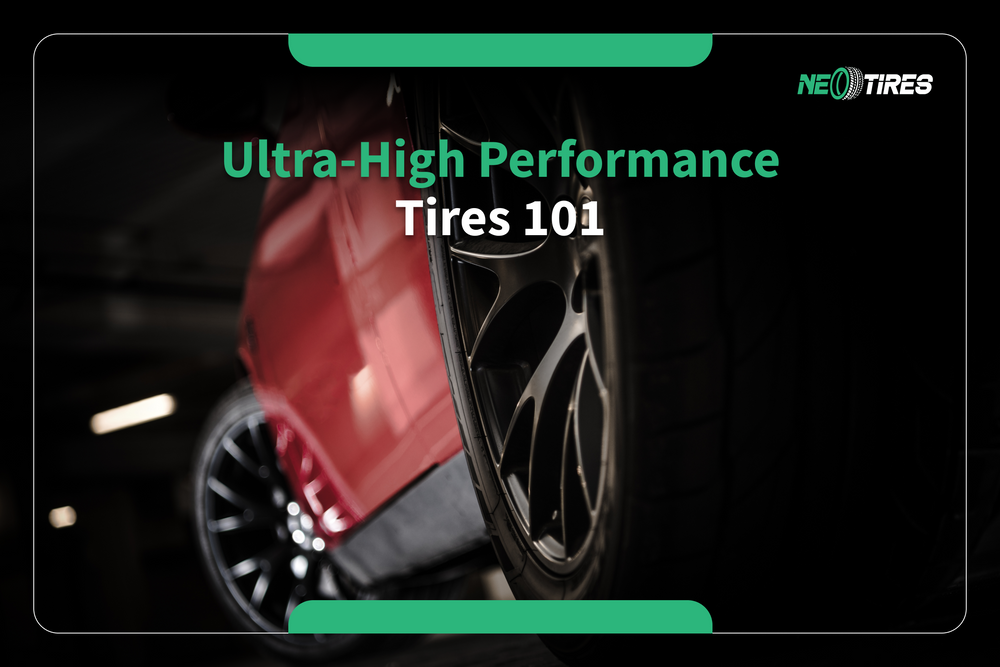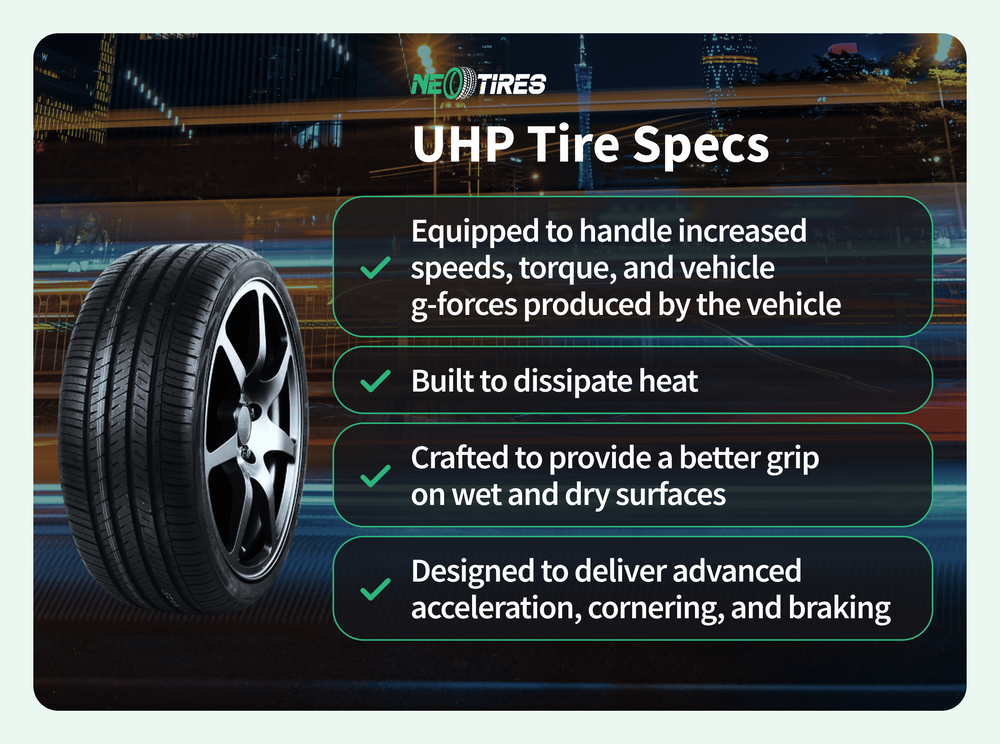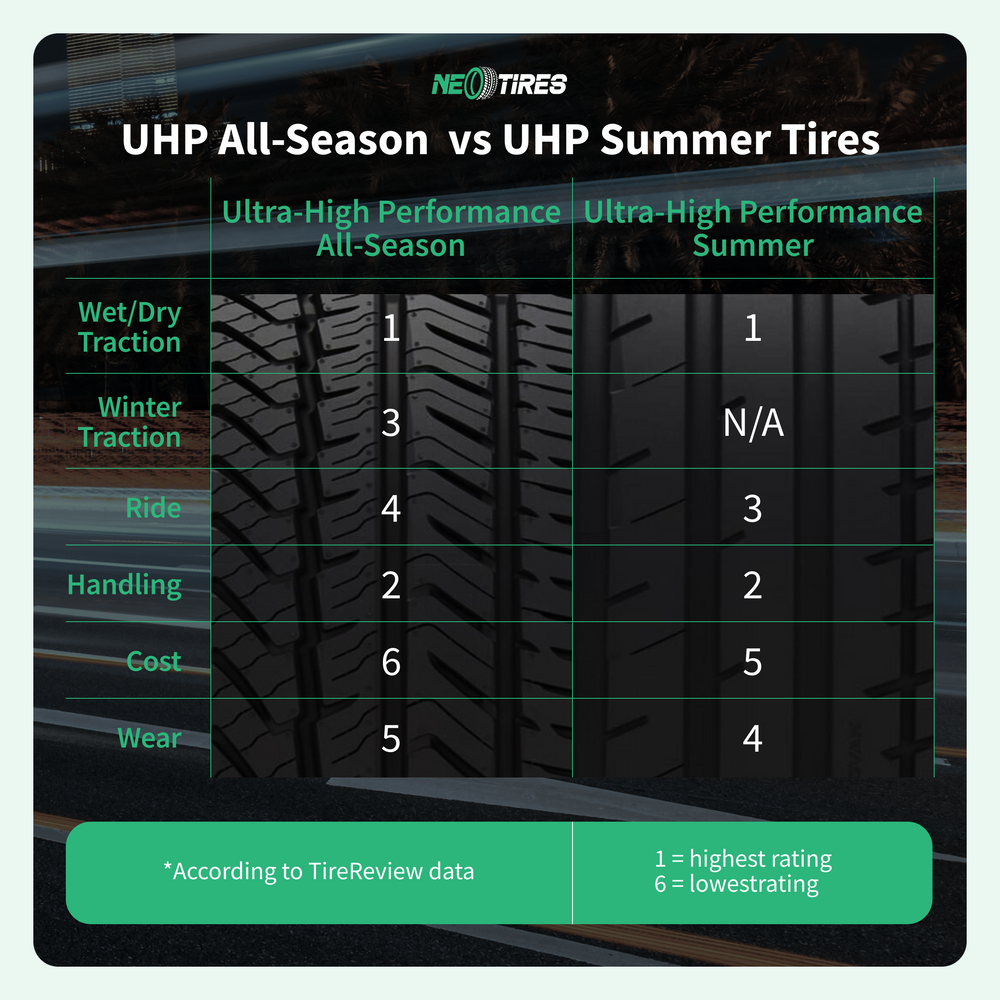Ultra-high-performance (UHP) tires are engineered for drivers who demand sharper steering, stronger cornering grip, shorter braking distances, and better high-speed stability than standard all-season or summer tires. UHP tires are not just a label - they represent a combination of advanced compounds, reinforced structures, and precision tread designs that translate driver inputs into predictable, confident behavior on both dry and wet roads.
In this guide, we’ll cover what UHP means, the differences between summer and all-season UHP tires, real-world performance, tire construction, market trends, and how to determine if UHP tires are worth the investment.
What Is a UHP Tire Category?
Tire experts and manufacturers typically categorize passenger tires based on comfort, performance, and handling capability. UHP tires sit near the top of this hierarchy:
From comfort to track performance: Touring → Performance → Ultra-High-Performance (UHP) → Max Performance → Extreme/Track
The UHP tire category differs from the standard passenger category through softer compounds, reinforced sidewalls, and precise tread patterns. These design elements ensure high-speed stability and cornering precision, making UHP tires ideal for spirited driving while remaining street-legal.
What Does UHP Mean on a Tire? (UHP Tires Meaning)
UHP stands for Ultra-High-Performance. This designation denotes tires engineered to deliver significantly more grip and responsiveness than standard passenger tires. UHP tires are designed for vehicles that require precise steering, improved cornering, and stability at high speeds. Unlike standard options, UHP tires use special materials and stronger sidewalls. This helps them manage higher heat buildup and keep their shape under pressure.
Drivers often link UHP tires with sports cars, high-performance sedans, and some electric vehicles. These tires improve the driving experience by turning every steering adjustment into confident, controlled movement.
How UHP Tires Are Built
The engineering behind UHP tires is what sets them apart:
- Rubber Compounds: Softer and stickier blends with high silica and carbon black improve adhesion and cornering grip.
- Sidewall Reinforcement: Multi-layer inserts and/or small bead reinforcement (apex) using materials such as steel or specialized fabrics maintain structural integrity during aggressive steering.
- Cap Ply and Belts: High-strength fibers, such as aramid or nylon, resist heat and maintain tire shape at high speeds.
- Tread Patterns: Larger, rigid blocks, directional/asymmetric designs, fewer sipes- all work to maximize contact patch, reduce squirm, and increase lateral stability.
Construction Differences Table: Standard vs UHP Tires
| Component | Standard Tire | UHP Tire | Explanation |
|---|---|---|---|
| Compound | Hard | Soft/Performance | Standard tires use harder rubber for durability and longer tread life. UHP tires use softer, stickier compounds that enhance grip and handling but wear out faster. |
| Sidewall | Flexible | Reinforced | UHP tires have reinforced sidewalls that reduce flex during cornering and enhance stability at high speeds. Standard tires have more flexible sidewalls for a smoother ride. |
| Belt Package | Basic | Aramid/Nylon | UHP tires incorporate advanced materials like aramid and nylon for improved strength and high-speed performance, while standard tires use basic steel/polyester belts. |
| Tread Pattern | Comfort-focused | Stability/Grip-focused | Standard tires feature patterns designed for comfort and quiet, everyday driving. UHP tires use rigid tread patterns for maximum grip and high-performance handling. |
| Heat Tolerance | Moderate | High | UHP tires resist heat buildup from aggressive driving and high speeds. Standard tires have moderate heat tolerance for normal driving. |
Types of Ultra-High-Performance Tires
UHP tires generally fall into two categories: UHP Summer and UHP All-Season. Each is optimized for different climates and driving needs, as shown in the breakdown below:
UHP Summer Tires (Maximum Warm-Weather Performance)
UHP summer tires are made to provide top performance on dry roads and stability at high speeds. Their soft compounds boost grip, and reinforced sidewalls improve steering response. This design makes them well-suited for sports cars, performance sedans, and lightweight track cars.
However, while summer UHP tires perform well on dry surfaces, their effectiveness drops in cold temperatures, and they are not safe on snow or ice.
For a deeper dive into summer tires, including types, advantages, and target vehicles, see our dedicated guide: Summer Tires Explained.
Typical UHP Summer Tire Characteristics
See the typical characteristics of UHP summer tires in the table below:
Feature | Typical Range | Notes |
Speed Ratings | W, Y, (Y) | High heat tolerance, track-capable |
Dry Grip | ~0.90 - 1.00g* | Excellent cornering |
Braking | 104 - 115 ft (60-0 mph)* | Short emergency stopping distance |
Tread Life | 20,000–35,000* mi | Softer rubber wears faster |
Price | ~$200 - $350+* | Premium performance compounds |
*Dry grip, braking distance, treadlife, and price shown are estimates; real values depend on tire brand, driving conditions, and vehicle type.
Most Recommended UHP Summer Tires 2025
Several models stand out in 2025 for drivers seeking maximum performance: the Michelin Pilot Sport 5, which replaces the popular PS4S, offers excellent wear resistance and great grip on both wet and dry roads. The Continental SportContact 7 is a track-focused option that achieved the shortest dry braking distance in several tests, making it perfect for spirited driving and occasional track days.
Other strong choices include the Pirelli P Zero PZ5, which provides great cornering grip at high temperatures. It also comes in custom-tuned versions for brands like Porsche, BMW M, and Mercedes-AMG. The Bridgestone Potenza Sport and Goodyear Eagle F1 Asymmetric 6 complete the premium segment with reliable performance.
UHP All-Season Tires (Performance with Cold Flexibility)
UHP all-season tires offer strong performance with additional flexibility for colder climates. While they do not reach the extreme dry grip of summer UHP tires, they maintain high responsiveness and are safer on cold or lightly snowy roads.
All-season UHP tires are popular among drivers who need a balance between spirited driving performance and daily usability, especially in regions where temperatures occasionally drop below 45°F.
Typical Characteristics
- Often with V, W, or Y speed ratings (up to 149 mph or higher)
- Longer tread life than UHP summer tires (around 30,000 - 50,000 miles)
- Slightly smoother ride compared to UHP summer tires, but more precise, sharper, and more responsive than standard all-season tires
- Price range: $180 - $300 (estimate)
Most Recommended UHP All-Season Tires 2025
Leading UHP all-season models for 2025 include the Continental ExtremeContact DWS 06 Plus. It excels in wet handling and provides a 50,000-mile warranty, making it ideal for sports car owners in changing climates.
The Michelin Pilot Sport All Season 4 offers excellent handling, strong all-weather grip, and very good tread life.
The Pirelli P Zero All Season Plus and Bridgestone Potenza Sport A/S also provide strong options at competitive prices. They deliver reliable performance in various weather conditions without losing the responsive feel that enthusiasts want.
Comparison: UHP Summer vs. UHP All-Season
See the difference between the UHP summer and the UHP All-Season tires in the table below:
Feature | UHP Summer | UHP All-Season |
Dry Grip | Highest | High |
Wet Grip | High | Moderate - High |
Cold Safety | Poor <45°F | Good |
Snow Use | Unsafe | Light snow capable |
Ride | Firm | Slightly smoother |
Noise | Higher | Moderate to low |
Best For | Warm climates, spirited driving | Mixed climates, daily use |
UHP Tires vs. Standard Tires: Real-World Differences
The primary difference between UHP and standard tires is in handling and braking. UHP tires use stiffer sidewalls and larger tread shoulders, which reduce squirm and provide immediate feedback during steering. This makes cornering sharper and more predictable.
Industry Tests
Independent tests suggest that premium or UHP tires often stop several feet sooner than mid-range or budget all-season tires under the same conditions. For example, a recent TÜV SÜD-commissioned test found that mid-range (standard) tires needed an average of about 7.6 feet more braking distance, while budget tires needed about 14.7 feet more braking distance from about 50 mph compared to premium (UHP) tires.
Moreover, in the 2025 Sport Auto UUHP test, a top-tier UHP tire, the Continental SportContact 7, achieved one of the shortest recorded dry-braking distances. This highlights the potential advantage UHP tires offer under favorable conditions.
Performance gains can differ based on the vehicle, tire brand or model, road surface, temperature, and other factors. While UHP tires usually improve stopping, the specific difference cannot be predicted universally.
UHP Drawbacks & Trade-Offs
UHP Summer Tires
- Short tread life: 20,000-35,000 miles typically
- Firm ride quality due to stiff sidewalls
- Road noise: slightly higher than touring summer tires
- Fuel economy may be slightly lower than touring summer tires due to stickier rubber compounds and higher rolling resistance.
UHP All-Season Tires
- Reduced dry performance vs summer UHP; All-season compounds are slightly harder, which reduces ultimate grip and cornering precision on dry roads.
- Moderate snow/ice performance; They handle light snow but are not a replacement for dedicated winter tires.
- Slightly less responsive steering compared to Summer UHP; the sidewall and tread trade-offs of UHP AS tires reduce razor-sharp feedback.
- Price premium (on average, $180 -$300): The higher cost compared to standard all-season tires may be a consideration for some buyers.
UHP Tire Market: Size, Share, and Trends
The Ultra-High-Performance (UHP) tire segment is one of the fastest-growing areas of the tire market. Recent market research estimates place the global high-performance tire market at over USD 55 billion in 2025, with forecasts pointing to nearly USD 83 billion by 2030, reflecting strong demand from performance, luxury, and premium vehicles (Mordor Intelligence, 2025).
Segment-specific analyses suggest that the UHP tire market alone could reach about USD 39 billion by 2033. This is an increase from the low-teens billion USD today (FutureMarketingInsights 2025). This growth shows the rising popularity of performance sedans, sports cars, and electric vehicles. Their weight, instant torque, and handling needs fit well with UHP tire features.
Emerging Trends in UHP Tires
EV-specific UHP tires
As electric vehicles gain market share, manufacturers are introducing UHP tires designed to handle higher torque and heavier weight while keeping low rolling resistance.
Electric vehicle owners already have specialized UHP options designed for their unique needs. For example, the Michelin Pilot Sport EV balances exceptional grip, range efficiency, and noise reduction using sustainable materials and reinforced sidewalls for high-torque demands. The Hankook iON EVO AS IH01 earned recognition for efficiency, while the Goodyear ElectricDrive 2 incorporates Sound Comfort Technology to minimize road noise in quiet EV cabins while maintaining low rolling resistance for extended range.
Reinforced sidewalls and belts
UHP tires are increasingly made with stronger belt and carcass materials to improve stability under high torque and keep their shape at sustained speeds.
Low rolling resistance compounds
While exact range gains are hard to quantify publicly, UHP tires made for EVs use special compounds and tread designs to cut energy loss, which may help improve efficiency and driving range.
Lightweight materials
Some modern UHP designs use lightweight fibers like aramid in the belt or cap ply. This reduces weight and improves handling while also boosting structural stability, which is crucial for both high-performance ICE vehicles and EVs.
These trends show how UHP tires are evolving, not just for sports cars and performance sedans, but also for the growing EV market, where performance, durability, and efficiency meet.
Making the Right Choice: Is a UHP Tire Right for You?
Ultra-high-performance tires are a major upgrade for drivers who want precision, responsiveness, and confident handling. UHP tires can change your driving experience, whether you drive a sports sedan, luxury coupe, or performance-oriented electric vehicle; however, they aren't suitable for everyone.
Choose UHP tires if you:
- Drive a sports vehicle, performance sedan, or high-powered electric vehicle that needs better grip and handling
- Regularly navigate winding roads or enjoy spirited driving where responsiveness is important
- Value shorter braking distances and cornering stability
- Live in places where dedicated summer or performance all-season abilities are beneficial
Think about other options if you:
- Value maximum tread life and expect to get over 40,000 miles
- Mainly drive in harsh winter conditions that require dedicated winter tires
- Prefer comfort and a quiet ride over performance
- Rarely push your vehicle past normal commuting speeds
When picking UHP tires, choose the type that fits your climate. Summer UHP tires offer maximum performance but become unsafe below 45°F. UHP all-season models provide year-round versatility with only slight performance trade-offs.
Ready to Upgrade?
Modern UHP tires from top manufacturers like Michelin, Continental, Pirelli, and Bridgestone provide outstanding performance based on thorough testing. Whether you pick the track-focused Continental SportContact 7, the versatile Michelin Pilot Sport All Season 4, or an EV-specific option like the Hankook iON EVO AS, you are investing in technology that enhances safety and performance.
Drive safe, and choose your tires wisely!







